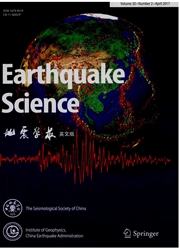

 中文摘要:
中文摘要:
Earthquake events from the Indonesian subduction zone recorded in northern Australia show a long and high-frequency coda associated with both P and S waves. Regional events recorded by Warramunga array in northern Australia can separate out wave propagation through the mantle by focusing on the coherent signal across the medium-aperture array. Most of the incoherent wave components result from structures in the vicinity of the array with small-scale lengths of 1–2 km or smaller. The coherent phases with relatively rapid changes in waveforms are associated with the scattering of seismic waves by crustal and mantle heterogeneity, but in some case can be related to structural effects near the source. As the depth of the source increases, the coherent portion of the seismic wavefield tends to become much simpler, which suggests that the heterogeneity tends to weaken at depth with larger-scale length. We compare the coherent signal features of earthquakes from the Indonesian subduction zone that have occurred in recent years with those in the early 1980s, first studied by Kennett(Phys Earth Planet Inter 47: 319–332, 1987). The general characteristics of the coherent signal variation with depth in recent years are the same as those observed in 1980s, but the variations are larger. This change suggests a stringer variation in heterogeneity with depth than before, which may bear important information about the dynamic processes and evolution of the crust and upper mantle.
 英文摘要:
英文摘要:
Earthquake events from the Indonesian subduction zone recorded in northern Australia show a long and high-frequency coda associated with both P and S waves. Regional events recorded by Warramunga array in northern Australia can separate out wave propagation through the mantle by focusing on the coherent signal across the medium-aperture array. Most of the incoherent wave components result from structures in the vicinity of the array with small-scale lengths of 1-2 km or smaller. The coherent phases with relatively rapid changes in waveforms are associated with the scattering of seismic waves by crustal and mantle heterogeneity, but in some case can be related to structural effects near the source. As the depth of the source increases, the coherent portion of the seismic wavefield tends to become much simpler, which suggests that the heterogeneity tends to weaken at depth with larger-scale length. We compare the coherent signal features of earthquakes from the Indonesian subduction zone that have occurred in recent years with those in the early 1980s, first studied by Kennett (Phys Earth Planet Inter 47: 319-332, 1987). The general characteristics of the coherent signal variation with depth in recent years are the same as those observed in 1980s, but the variations are larger. This change suggests a stringer var- iation in heterogeneity with depth than before, which may bear important information about the dynamic processes and evolution of the crust and upper mantle.
 同期刊论文项目
同期刊论文项目
 同项目期刊论文
同项目期刊论文
 Approximate Solutions to the Boundary–Volume Integral Equation for Wave Propagation in Piecewise Het
Approximate Solutions to the Boundary–Volume Integral Equation for Wave Propagation in Piecewise Het Application of deep-towed multichannel seismic system for gas hydrate on mid-slope of northern Casca
Application of deep-towed multichannel seismic system for gas hydrate on mid-slope of northern Casca 期刊信息
期刊信息
